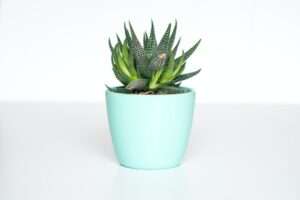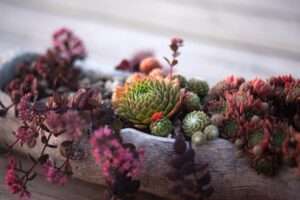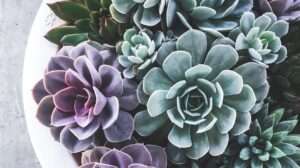Succulent terrariums have become increasingly popular in recent years as a unique and low-maintenance way to bring nature indoors. These miniature gardens consist of various types of succulent plants arranged in a glass container, creating a beautiful and self-contained ecosystem. The appeal of succulent terrariums lies in their ability to add a touch of greenery and natural beauty to any space, while requiring minimal care and attention.
The Benefits of Having a Succulent Terrarium in Your Home
One of the key benefits of having a succulent terrarium in your home is its ability to purify the air. Succulents, like other plants, absorb carbon dioxide and release oxygen through the process of photosynthesis. This can help improve the air quality in your home by reducing the levels of harmful pollutants and toxins.
In addition to their air-purifying properties, succulent terrariums can also help reduce stress and promote relaxation. Studies have shown that being around nature can have a calming effect on the mind and body, helping to reduce anxiety and promote a sense of well-being. The presence of a succulent terrarium in your home can create a peaceful and serene atmosphere, providing a natural escape from the stresses of everyday life.
Furthermore, succulent terrariums are aesthetically pleasing and can enhance the overall look and feel of any space. With their unique shapes, colors, and textures, succulents add visual interest and can serve as a focal point or conversation starter in any room. Whether placed on a windowsill, coffee table, or desk, a succulent terrarium can instantly brighten up a space and bring a touch of nature indoors.
Choosing the Right Container for Your Succulent Terrarium
When it comes to choosing the right container for your succulent terrarium, there are several factors to consider. First and foremost, you’ll want to think about the size and shape of the container. The size of the container will depend on the number and size of the succulents you plan to include. It’s important to choose a container that is large enough to accommodate the plants without overcrowding them, but not so large that it overwhelms the space.
In terms of shape, there are a variety of options to choose from, including round, square, and rectangular containers. The shape you choose will depend on your personal preference and the style of your home. Round containers tend to have a more organic and natural look, while square and rectangular containers can create a more modern and structured aesthetic.
Another important consideration when choosing a container for your succulent terrarium is the material it is made from. Glass containers are a popular choice because they allow for maximum visibility and create a beautiful display. However, other materials such as ceramic or concrete can also be used to create unique and visually appealing terrariums.
Lastly, it’s important to consider the drainage requirements of your succulent terrarium. Succulents are desert plants that are adapted to dry conditions, so it’s crucial that excess water can drain out of the container. Look for containers that have drainage holes or consider adding a layer of gravel or activated charcoal at the bottom of the container to help with drainage.
How to Choose the Perfect Succulents for Your Terrarium
Choosing the right succulents for your terrarium is essential for creating a visually appealing and harmonious arrangement. When selecting succulents, consider their size and growth habits. Some succulents, like Echeveria and Aloe vera, grow in rosette shapes and stay relatively compact, making them ideal for small terrariums. Others, like Sedum and Crassula, have trailing or cascading growth habits that can add depth and dimension to your terrarium.
In addition to size and growth habits, consider the color and texture of the succulents you choose. Succulents come in a wide range of colors, from vibrant greens to deep purples and blues. Consider the color scheme of your space and choose succulents that complement or contrast with the existing decor. Similarly, pay attention to the texture of the succulents. Some have smooth, fleshy leaves, while others have spiky or hairy textures. Mixing different textures can create visual interest and add depth to your terrarium.
Lastly, consider the compatibility of the succulents you choose. Some succulents have similar care requirements and can be planted together without issue. However, others may have different water, light, or temperature needs that make them incompatible. It’s important to research the care requirements of each succulent and choose ones that have similar needs to ensure they thrive in your terrarium.
The Importance of Proper Soil for Your Succulent Terrarium
Proper soil composition is crucial for the health and well-being of your succulent terrarium. Succulents require well-draining soil that allows excess water to flow through easily. This is because succulents are adapted to dry conditions and are prone to root rot if they sit in waterlogged soil for too long.
When choosing soil for your succulent terrarium, look for a mix specifically formulated for succulents or cacti. These mixes are typically made up of a combination of organic matter, such as peat moss or coconut coir, and inorganic materials like perlite or pumice. The organic matter helps retain moisture, while the inorganic materials provide drainage and prevent compaction.
In addition to proper soil composition, it’s important to ensure that your terrarium has adequate drainage. This can be achieved by using a container with drainage holes or by adding a layer of gravel or activated charcoal at the bottom of the container. These materials help create a barrier between the soil and the water, allowing excess moisture to drain away.
Lastly, succulents have relatively low fertilizer requirements compared to other plants. Over-fertilizing can lead to excessive growth and weak, leggy plants. It’s best to use a slow-release fertilizer specifically formulated for succulents and follow the instructions on the packaging. Remember, it’s always better to under-fertilize than over-fertilize when it comes to succulents.
Caring for Your Succulent Terrarium: Watering, Light, and Temperature

Proper care is essential for the health and longevity of your succulent terrarium. When it comes to watering, succulents prefer to be slightly underwatered rather than overwatered. It’s important to allow the soil to dry out completely between waterings to prevent root rot. The frequency of watering will depend on factors such as the size of your terrarium, the type of succulents you have, and the environmental conditions in your home. As a general rule of thumb, water your succulent terrarium when the soil feels dry to the touch.
In terms of light requirements, succulents thrive in bright, indirect light. Place your terrarium near a window that receives bright, filtered light for several hours a day. Avoid placing your terrarium in direct sunlight, as this can cause sunburn and damage the leaves of your succulents.
Temperature considerations are also important when caring for your succulent terrarium. Most succulents prefer temperatures between 60-80°F (15-27°C). Avoid placing your terrarium near drafts or in areas with extreme temperature fluctuations, as this can stress your plants.
DIY Succulent Terrariums: Step-by-Step Guide
Creating your own succulent terrarium can be a fun and rewarding DIY project. Here is a step-by-step guide to help you get started:
Materials needed:
– Glass container with drainage holes or a layer of gravel/activated charcoal
– Succulent plants
– Succulent soil mix
– Decorative elements (optional)
– Watering can or spray bottle
Step 1: Prepare your container by ensuring it has proper drainage. If your container does not have drainage holes, add a layer of gravel or activated charcoal at the bottom to help with drainage.
Step 2: Fill the container with succulent soil mix, leaving enough space for the succulents to be planted.
Step 3: Carefully remove the succulents from their pots and gently loosen the roots. Place them in the container, arranging them in a way that is visually pleasing. Leave enough space between the plants to allow for growth.
Step 4: Once the succulents are planted, gently press down on the soil to secure them in place. Be careful not to compact the soil too much, as this can hinder drainage.
Step 5: If desired, add decorative elements such as rocks, pebbles, or moss to enhance the visual appeal of your terrarium.
Step 6: Water your terrarium lightly, making sure not to overwater. Use a watering can or spray bottle to moisten the soil without saturating it.
Step 7: Place your terrarium in a location that receives bright, indirect light. Avoid placing it in direct sunlight, as this can cause sunburn and damage the leaves of your succulents.
Step 8: Monitor your terrarium regularly and water only when the soil feels dry to the touch. Remember, succulents prefer to be slightly underwatered rather than overwatered.
Tips for success:
– Choose succulents with similar care requirements to ensure they thrive together.
– Avoid overcrowding your terrarium by leaving enough space between plants.
– Experiment with different textures and colors to create visual interest.
– Regularly rotate your terrarium to ensure even light exposure on all sides.
Creative Ideas for Decorating Your Succulent Terrarium
Decorating your succulent terrarium can be a fun and creative way to personalize your space. Here are some ideas to get you started:
– Adding decorative elements: Consider adding decorative elements such as rocks, pebbles, or seashells to enhance the visual appeal of your terrarium. These elements can add texture and create a more natural and organic look.
– Incorporating different textures and colors: Mix and match succulents with different textures and colors to create visual interest. Combine succulents with smooth, fleshy leaves with those that have spiky or hairy textures for a unique and eye-catching display.
– Creating a themed terrarium: Get creative and create a themed terrarium based on your interests or hobbies. For example, you could create a beach-themed terrarium by adding sand, seashells, and miniature beach chairs. Or, create a desert-themed terrarium by using succulents that resemble cacti and adding small desert-themed figurines.
Common Mistakes to Avoid When Creating a Succulent Terrarium
While succulent terrariums are relatively low-maintenance, there are some common mistakes to avoid to ensure the health and longevity of your plants:
– Overwatering: Succulents are adapted to dry conditions and are prone to root rot if they sit in waterlogged soil for too long. It’s important to allow the soil to dry out completely between waterings and avoid overwatering.
– Choosing incompatible plants: Some succulents have different water, light, or temperature requirements that make them incompatible when planted together. It’s important to research the care requirements of each succulent and choose ones that have similar needs.
– Neglecting light and temperature requirements: Succulents thrive in bright, indirect light and prefer temperatures between 60-80°F (15-27°C). Neglecting these requirements can lead to weak, leggy plants or sunburned leaves.
Enjoying the Beauty of Succulent Terrariums in Your Home
In conclusion, succulent terrariums are a popular and visually appealing way to bring nature indoors. They offer a range of benefits, including air purification, stress reduction, and aesthetic appeal. When creating your own succulent terrarium, it’s important to choose the right container, select the perfect succulents, use proper soil, and provide the right care in terms of watering, light, and temperature. By following these guidelines and avoiding common mistakes, you can enjoy the beauty of succulent terrariums in your home and create a unique and low-maintenance piece of living art. So why not give it a try and create your own succulent terrarium today?
If you’re a succulent enthusiast, you may also be interested in learning about common mistakes that can lead to your succulents dying. Check out this informative article on GirlsGist: Why Are My Succulents Dying? Common Mistakes and How to Save Them. It provides valuable insights and tips on how to keep your succulents thriving and avoid potential pitfalls.
FAQs
What are succulent terrariums?
Succulent terrariums are miniature gardens that are created in glass containers and filled with various types of succulent plants. They are designed to be low-maintenance and can be used as decorative pieces in homes or offices.
What types of succulent plants can be used in terrariums?
There are many types of succulent plants that can be used in terrariums, including echeveria, sedum, haworthia, and crassula. These plants are chosen for their ability to thrive in low-moisture environments and their unique shapes and colors.
What materials are needed to create a succulent terrarium?
To create a succulent terrarium, you will need a glass container, succulent plants, potting soil, sand or gravel, and decorative elements such as rocks or moss. Optional items include activated charcoal, which can help with drainage, and a spray bottle for watering.
How do you care for a succulent terrarium?
Succulent terrariums are low-maintenance and require minimal care. They should be placed in a location with bright, indirect sunlight and watered sparingly, only when the soil is completely dry. Overwatering can lead to root rot and other issues.
Can succulent terrariums be used as gifts?
Yes, succulent terrariums make great gifts for friends and family. They are unique and thoughtful presents that can be customized to fit the recipient’s style and preferences. They are also easy to care for, making them a great option for those who may not have a green thumb.

















Add Comment